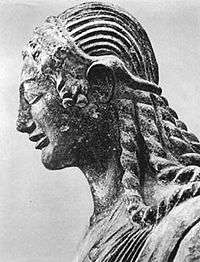Apollo of Veii
|
Detail of the head | |
| Artist | Vulca |
|---|---|
| Year | c. 550-520 BCE |
| Type | Terracotta |
| Dimensions | 180 cm (71 in) |
| Location | National Etruscan Museum, Rome |
The Apollo of Veii is an over-life-size painted terracotta Etruscan statue of Apollo (Aplu). The statue was discovered in the Portonaccio sanctuary of ancient Veii and dates from c. 510 - 500 BC. It was created in the so-called "international" Ionic or late-archaic Etruscan style.[1] It was discovered in 1916, and is now on display in the National Etruscan Museum in Rome.[1]
The statue was probably made by Vulca, the only Etruscan artist whose name is known.[2] It was part of a scene of Apollo and Heracles contending over the Ceryneian Hind, 12 metres above the ground on beams on the acroterion of the Portonaccio Sanctuary of Minerva.[3] The statue is dressed in a tunic and short cloak, advancing towards the left with the right arm outstretched and bent (the statue's left arm is towards the ground and may have held a bow).
Together with other statues, it decorated the roof beams of the Portonaccio temple, a sanctuary dedicated to Minerva. Placed on high plinths, these statues functioned as acroterial. They stood some twelve metres above the ground level and even though they were created separately, they narrated events from Greek mythology at least in part tied to the god Apollo. The statue, together with the statue of Heracles, formed a group representing one of the labours of the hero before his apotheosis among the divinities of Olympus. The myth narrates the contention between the god and the hero for the possession of the doe with the golden horns. There was probably also a statue of Mercury united to this group of which only the head and a part of the body remain. Apollo, dressed in a tunic and short cloak advances towards his left with his right arm outstretched and bent (his left arm is towards the ground maybe with a bow in his hand); Heracles, with the doe tied around his legs, is outstretched towards the right, leaning forwards to attack with his bludgeon and with his torso in a violent curve.
The group was conceived for a lateral vision and the solid volume of the figures united with the dissymmetry both in Apollo (the torso and face) and Heracles torso suggest that the artist was knowledgeable regarding optical deformations. The style of the statues is in the ambit of the “international” Ionic manner that characterizes not only the Etruscan artistic culture of the late archaic period of the last years of the 6th century BC but the result achieved reaches very high expressive levels. The creator of the acroterial statues can be identified as the “Artist from Veio, an expert in coroplastic art”.
Sources
References
- 1 2 Horst Woldemar Janson; Anthony F. Janson (2003). History of Art: The Western Tradition. Prentice Hall Professional. pp. 172–. ISBN 978-0-13-182895-7.
- ↑ Barbara E. Borg (9 September 2015). A Companion to Roman Art. Wiley. pp. 97–. ISBN 978-1-118-88609-0.
- ↑ Giuliano Bonfante; Larissa Bonfante (2002). The Etruscan Language: An Introduction, Revised Edition. Manchester University Press. pp. 17–. ISBN 978-0-7190-5540-9.
